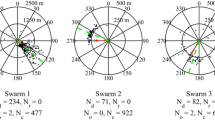Abstract
A curious feature of the honeybee's waggle dance is the imprecision in the direction indication for nearby food sources. One hypothesis for the function of this imprecision is that it serves to spread recruits over a certain area and thus is an adaptation to the typical spatial configuration of the bees' food sources, i.e., flowers in sizable patches. We report an experiment that tests this tuned-error hypothesis. We measured the precision of direction indication in waggle dances advertising a nest site (typically a tree cavity, hence a target that is almost a point) and compared it with that of dances advertising a food source (typically a flower patch, hence a target that covers an area). The precision of dances for a nearby nest site was significantly higher than that of dances for an equidistant feeder. This was demonstrated four times with four colonies. Our evidence therefore supports the hypothesis that the level of precision in the direction indication for nearby food sources is tuned to its optimum without being at its maximum.
Similar content being viewed by others
Author information
Authors and Affiliations
Additional information
Received: 9 December 1998 / Received in revised form: 24 February 1999 / Accepted 12 March 1999
Rights and permissions
About this article
Cite this article
Weidenmüller, A., Seeley, T. Imprecision in waggle dances of the honeybee (Apis mellifera) for nearby food sources: error or adaptation?. Behav Ecol Sociobiol 46, 190–199 (1999). https://doi.org/10.1007/s002650050609
Issue Date:
DOI: https://doi.org/10.1007/s002650050609




